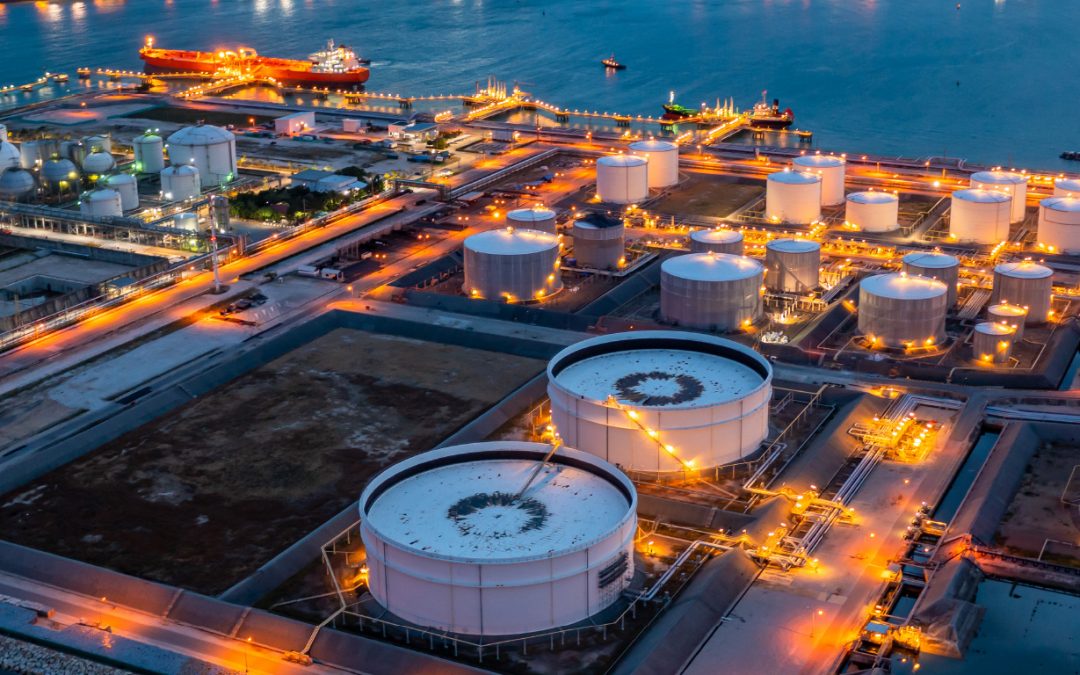Tank storage terminals represent a key element in the energy industry, as they provide a safe and efficient way to store and distribute petroleum-derived products and other hazardous liquids. However, they also entail a series of potential risks and threats to the environment.
The potential risks that tank storage terminals may face are the following:
- Emissions into the atmosphere: Tank storage operations can release atmospheric emissions of volatile organic compounds (VOCs), polycyclic aromatic hydrocarbons (PAHs), and other air pollutants. These pollutants can contribute to the formation of toxic fog or smog, acid rain, and other air quality issues. Currently, industries focus on the optimal design and maintenance of tanks, pipelines, and other equipment to reduce diffuse emissions. Channelized emissions, including vapors generated during processes like tank filling and emptying, are directed to Processing Units such as Regenerative Thermal Oxidizers (RTO) and Vapour Recovery Units (VRU) for treatment. This not only recovers valuable substances, preventing product loss but also reduces air pollution and complies with current environmental legislation.
- Hazardous Waste: Tank storage operations can generate hazardous wastes, such as tank sludges, wastewater, and contaminated equipment. These wastes must be properly managed and disposed of to prevent environmental contamination.
- Leaks and Spills: Leaks and spills of petroleum products and other hazardous liquids can contaminate soil, groundwater, and surface water bodies. This can have a devastating impact on wildlife, ecosystems, and human health.
- Fires and Explosions: Storage tanks can be susceptible to fires and explosions, which can cause property damage, personal injuries, and environmental contamination.
To mitigate these environmental risks, companies operating tank storage terminals must implement a series of safety and environmental protection measures, including:
- Safe Design and Construction: Storage tanks must be designed and constructed in accordance with applicable standards and regulations to ensure their structural integrity and resistance to leaks and spills.
- Inspection and Maintenance: Storage tanks should undergo regular inspection and maintenance to detect and repair any potential issues.
- Containment Systems: Storage tanks must be equipped with containment systems to capture and contain any leaks or spills.
- Use of Vapour Recovery Units: Chemical adsorption and desorption can recover up to 99% of valuable vapours during operations such as truck loading and unloading, optimizing terminal efficiency and contributing to environmental protection. Vapour Recovery Units (or VRU) are the solution to recover product at tank terminals.
- Waste Valorization Plants: One solution is the installation of Waste Valorization Plants that transform these wastes into energy or usable products. This allows for economic benefits and promotes sustainability by recycling wastes with certain chemical properties or high calorific value. Wastes can be converted into steam, electricity, or raw materials, such as Pyrolysis Oil, used in the production of second-generation plastics and biofuels.
- Emergency Plans: Tank storage terminals must develop and implement emergency plans to respond to leaks, spills, fires, explosions, and other potential risks.
- Staff Training: Tank storage sector personnel should receive training on the environmental risks associated with their activities and the safety and environmental protection measures they need to implement.
By implementing these measures, tank storage terminals can significantly reduce the environmental risks associated with their operations and protect human health and the environment.
Regulatory Compliance
Furthermore, it is important to emphasize that compliance with local, national, and international regulations and standards is essential in this sector. These regulations are designed to minimize environmental impacts and ensure the safety of tank storage operations.
Companies in the sector must comply with all applicable regulations and standards, which may include requirements for hazardous waste management, spill and leak prevention, and reduction of atmospheric emissions. This involves obtaining permits, conducting audits, and regularly reporting to the relevant authorities.
Technological Innovation
The adoption of advanced technologies can help companies in the sector improve the efficiency of their tank storage operations and reduce their environmental impact. This may include the use of sensors and monitoring systems to detect leaks and spills, emissions control systems to reduce the release of air pollutants, and waste treatment technologies to safely manage and eliminate hazardous waste.
Corporate Social Responsibility
Tank storage terminals must also commit to corporate social responsibility, which involves considering the impact of their operations on the local community, the health of workers, and the environment. This may include implementing community outreach programs, improving working conditions, and investing in environmental conservation projects.
In conclusion, although the tank storage sector presents evident environmental risks, the implementation of advanced technology for emission and waste treatment, environmental safety and protection measures, regulatory compliance, adoption of advanced technologies, and commitment to corporate social responsibility can help mitigate these risks and ensure a sustainable future for a safer and more efficient sector.
If you need further information, please contact us today.

